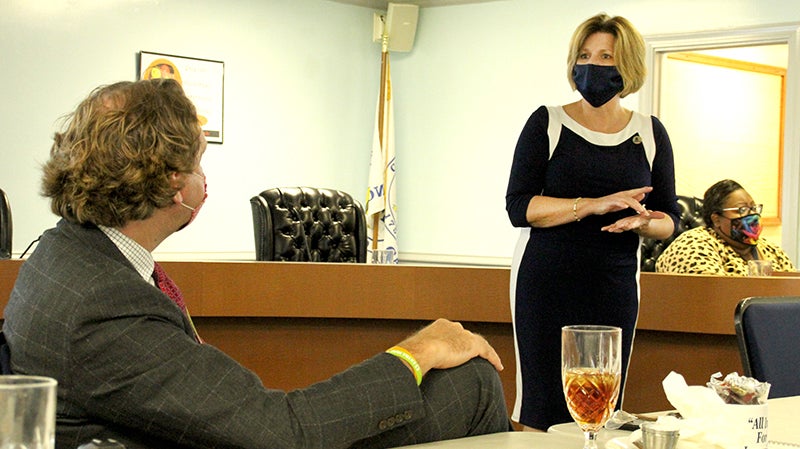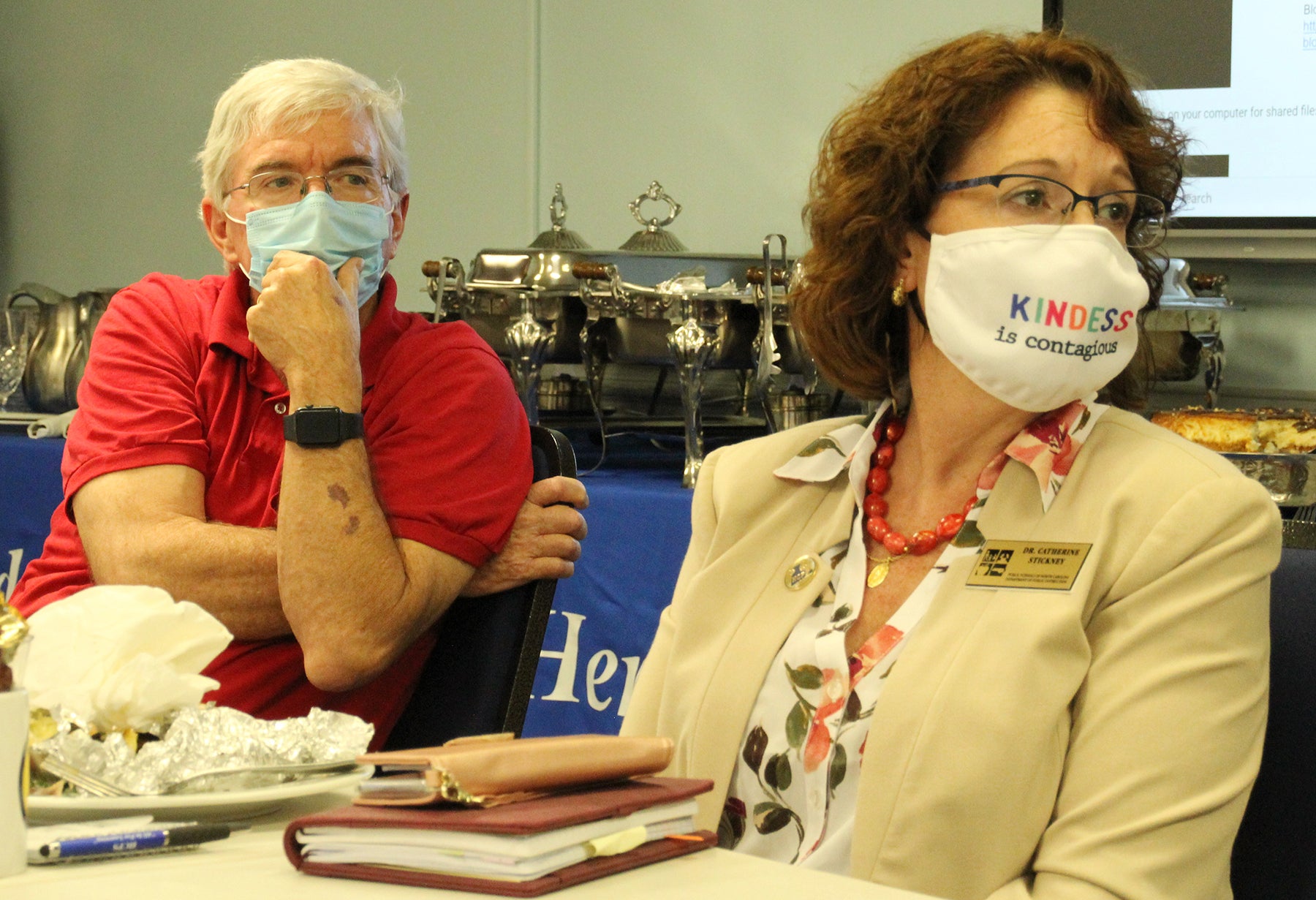Spotlight shines on Hertford County
Published 6:06 pm Friday, October 9, 2020

- Hertford County Public Schools Assistant Superintendent Tammi Ward answers a question posed by Freebird Mckinney (seated), Director of Legislative Affairs and Community Outreach on the State Board of Education, during the recent work session in Winton. Staff Photo by Cal Bryant
|
Getting your Trinity Audio player ready...
|
WINTON –Hertford County Public Schools (HCPS) was afforded a great opportunity here recently to showcase its programs, especially those dealing with remote learning due to the COVID-19 pandemic.
The county’s school leaders – to include Superintendent Dr. William T. Wright Jr., Assistant Superintendent Tammi Ward, Board of Education Chairman David Shields and member J. Wendell Hall, and Public Information Officer Brunett Parker hosted a luncheon and work session with regional and state educational administrators.
Guests attending were Dr. Beverly Emory, the former Superintendent of Winston-Salem / Forsyth County Schools who now is the Director of District Regional Support for the NC Dept. of Public Instruction; Freebird Mckinney, the state’s 2018 Teacher of the Year who serves as the Director of Legislative Affairs and Community Outreach on the State Board of Education; Dr. Catherine Stickney, Regional Case Manager for the Northeast Region; Jill Camnit who represents the 1st District on the State Board of Education; and State Senator Bob Steinburg.
The group attending the work session had the opportunity to eavesdrop on three virtual classes – one each at Bearfield Primary School, C.S. Brown STEM High School, and Hertford County Early College High School – as they were being conducted live.

David Shields, Chairman of the Hertford County Board of Education, and Dr. Catherine Stickney, Regional Case Manager for the Northeast Region, listen to a presentation at the work session. Staff Photo by Cal Bryant
Ward emphasized to the group that the local district has been on a three-year trek to open the doors to virtual learning for its current enrollment of 2,659 students. The same technology upgrades also apply to HCPS teachers who can now take advantage of things such as digital data notebooks, devices that can establish benchmarks and track the progress of each of their students.
Ward also touched on other HCPS initiatives, to include the Teacher Compensation Model, a grant for a STEM lab at the middle school, the Jumpstart program that focuses on supporting children’s language skills, literacy, and social-emotional development, and the Opportunity Culture program, which allowed for another grant for HCPS to use to design paths that can provide highly-skilled, master teachers with opportunities to increase their responsibilities—and compensation—without leaving the classroom entirely. That latter grant was for nearly $500,000 which is stretched over a three-year time frame.
There’s even a program used by HCPS to successfully communicate with the non English-speaking parents of students.
Another new program is Istation that provides computer-based assessment and instruction in reading and writing for PreK-12 students. Students complete game-based lessons and activities led by animated characters while the program generates reports on their progress for teachers, parents and administrators.
“I appreciate what you are doing here; you’re building the infrastructure for an exciting future,” said Dr. Emory.
Several teachers presented taped testimonials about how these initiatives and others are making an impact on how education is delivered in the county.
“Our educational journey into new and exciting programs is continuing,” Ward stressed. “One of the roadblocks we face here locally is internet access, especially high-speed internet, which also impacts cell phone service. We also face equity and funding issues.”
A question was posed about the level of internet access by HCPS students.
“There’s about 40 percent of our students without internet access or with inadequate access,” Dr. Wright answered. “I live in Ahoskie, three blocks from the high school. I can take you about five miles out of town in any direction and there’s a loss of service. Hot spots do help, but they don’t work without internet access. Obviously we need better infrastructure.”
Mckinney asked what help the state can provide in assisting HCPS in recruiting and retaining teachers.
“The problem for us is twofold: one is we have to find a way to increase the excitement about our profession – teaching,” Dr. Wright said. “Teaching is becoming less attractive as a career. Perhaps we can think about a teacher cadet program.
“Also, the [teacher] certification process…although we’ve made it more palatable, it’s still a mess,” he continued. “It’s more to it now than it was in 1998 when I first became a teacher without that being my focus n college. I was a business major. For us, in a rural area, it makes it even harder to hire qualified teachers, especially with bigger school districts around us that pay more and have larger [teacher] supplements, even up in Virginia.”
Answering a question from Steinburg, Dr. Wright said HCPS pays a teacher supplement that’s equal to three percent of their annual salary.
“Is there any room in the county’s budget to move that number [supplement percentage] up; has your school board talked to your county commissioners about this,” Steinburg asked.
“We’ve had those conversations [with the commissioners] and our [local] funding has been level for the last three years,” Dr. Wright said. “And they just gave us $6 million to build a new elementary school, so they’re alright with me.”
Again, the question was posed of what Hertford County needs to grow. Shields answered quickly, saying better roads are the key to economic stability.
“If we had better roads, more four-lane highways, we don’t need handouts; the money will come to us because of more business opportunities,” he said, adding that improvements to the NC 11 corridor would be of great benefit to the county and to the region. “We just need to be treated fairly by the state when it comes to transportation projects.”
Hall agreed.
“You have to realize that 35 percent of our workforce travel out of state everyday,” Hall pointed out. “That’s the issue, lack of jobs. Better roads will bring more jobs here, better paying jobs. Those new industries will also expand our tax base, giving us more money hire quality teachers.”
“I see Hertford County as a sleeping giant; the potential here, the work ethic here, is pretty significant,” Steinburg observed. “You have the potential to become the industrial hub of the northeast region.”
“You have a lot of incredible initiatives going on here, to include your Opportunity Culture program,” stated Dr. Emory. “My question is do you have enough support to help you monitor your metrics so that in the end you can show what you’re doing is working? What can the state do to help you monitor and track those metrics?”
“As many are led to believe, our challenge here is how rural we are, but after being here for five years now, perception is not reality,” Dr. Wright said. “We are better than people think we are. But to answer your question, I wish the state would follow what South Carolina did and develop a ‘districts like us program.’ It compares like districts with similar numbers and then that helps us with tracking similar metrics which then helps with recruiting and retaining educators.”
“You’re right, by comparing similar metrics in like districts, Hertford County would be at or near the top,” Dr. Emory noted.
Dr. Wright also touched on Governor Cooper’s recent decision to allow local school districts to return to face-to-face learning in a year that has seen COVID-19 cause many school districts statewide to teach via a remote learning format.
“Our kids want to return to class, but for us the [COVID] data is trending differently here than the rest of the state,” Dr. Wright remarked. “The state’s numbers seem to be going down. Hertford County is trending in the other direction. Our county is in the moderate risk category, but yet learning is still taking place.”
Other discussion involved a possible change in the state’s ADM (Average Daily Membership formula in an effort to help more rural districts; and more consistent levels of funding from other pots of state and federal funding.


